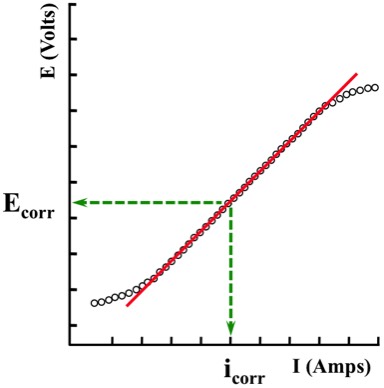Currently viewing
Menu
Polarization Resistance Test
This Direct Current (DC) Test may also be termed Linear Polarization Resistance (LPR).
One of the primary advantages of this particular type of Test is that the sample is only polarized by about 20 or 30 millivolts; therefore, the sample is not significantly damaged. As a result, it is possible to repeatedly test the same sample and develop a time-dependent picture of the change in corrosion rate.

One of the primary advantages of this particular type of Test is that the sample is only polarized by about 20 or 30 millivolts; therefore, the sample is not significantly damaged. As a result, it is possible to repeatedly test the same sample and develop a time-dependent picture of the change in corrosion rate.

It is important to note that the "x" axis - I (Amps) (current in Amps) - in the above Figure is linear (not logarithmic). The slope of the curve has units of resistance - hence the term Polarization Resistance (Rp). The tangent to the curve at Ecorr defines the Polarization Resistance (Rp).
If you know the Tafel slopes, it is possible to define icorr as follows:
If you know the Tafel slopes, it is possible to define icorr as follows:
icorr = (ßa ßc)/2.3(ßa+ ßc) • (1/Rp)
Currently viewing
Page last updated: 3/4/25
